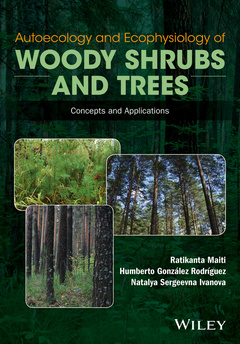Description
Autoecology and Ecophysiology of Woody Shrubs and Trees
Concepts and Applications
Authors: Maiti Ratikanta, Rodriguez Humberto Gonzalez, Ivanova Natalya Sergeevna
Language: English
Subject for Autoecology and Ecophysiology of Woody Shrubs and Trees:
Keywords
autoecology; ecophysiology; plant ecology; trees; forestry; forest ecology; woodland ecology; woodlands; shrubs; shrubbery
118.16 €
In Print (Delivery period: 14 days).
Add to cart368 p. · 17x25.2 cm · Hardback
Description
/li>Contents
/li>Biography
/li>
Forest trees and shrubs play vital ecological roles, reducing the carbon load from the atmosphere by using carbon dioxide in photosynthesis and by the storage of carbon in biomass and wood as a source of energy. Autoecology deals with all aspects of woody plants; the dynamism of populations, physiological traits of trees, light requirements, life history patterns, and physiological and morphological characters. Ecophysiology is defined by various plant growth parameters such as leaf traits, xylem water potential, plant height, basal diameter, and crown architecture which are, in turn, influenced by physiological traits and environmental conditions in the forest ecosystem. In short, this book details research advances in various aspects of woody plants to help forest scientists and foresters manage and protect forest trees and plan their future research.
Autoecology and Ecophysiology of Woody Shrubs and Trees is intended to be a guide for students of woody plant autoecology and ecophysiology, as well as for researchers in this field. It is also an invaluable resource for foresters to assist in effective management of forest resources.
Preface, vii
List of contributors, ix
1 Background, 1
Part I:
2 Autoecology, 15
3 Vegetation and biodiversity, 25
4 Case study: A trip to regions of biodiversity and rainforest in Riviera Maya, 31
5 Plant traits, 42
6 Leaf traits, 74
7 Wood characteristics, 83
8 Phenology, 111
9 Phenology, morphology and variability in pollen viability of four woody species (Cordia boissieri, Parkinsonia texana, P. aculeata and Leucophyllum frutescens) exposed to environmental temperature, north-eastern Mexico, 124
10 Pollen biology and plant productivity: A review, 133
11 Seed characteristics, 158
12 Tree mortality, 162
13 Plant traits related to the productivity of trees, 168
Part II:
14 Ecophysiology, 181
15 Research advances in plant ecophysiology, 190
16 Carbon capture, carbon sequestration and carbon fixation, 199
17 Plant nutrients, 220
18 Litterfall and forest productivity, 238
19 Nutrient cycling, 244
20 Plant water relations and forest productivity, 248
21 Cold tolerance of trees, 261
22 Heat stress tolerance of trees, 266
23 Seed characteristics, seed dormancy, germination and plant propagation, 270
24 Root growth, 278
25 Features of boreal forest in Russia: A special study, 285
26 Case study: Autoecology, biodiversity and adaptive characteristics of Prosopis in the Arizona region, 312
Appendix 1: Leaf Morphology, 325
Index, 333
Professor Ratikanta Maiti, Visiting Scientist, Forest Science Faculty, Universidad Autonoma de Nuevo Leon (UANL), Linares, Nuevo Leon, Mexico. Dr Maiti is a world renowned botanist and plant physiologist. He has published around 500 research papers and more than 30 books on plant science and crops, and has received various international awards.
Dr Humbero Gonzalez Rodriguez, Director, Forest Science Faculty, Universidad Autonoma de Nuevo Leon (UANL), Linares, Nuevo Leon, Mexico.Dr Rodriguez is a renowned plant physiology and author of several books. At UANL he works on various aspects of ecophysiology, with special reference to abiotic stress resistance. He has published more than 150 research papers.
Dr Natalya Sergeevna Ivanova, Senior Scientist, Botanical Garden of Ural Branch RAS, Professor of the Russian Academy of Natural Sciences, Ekaterinburg, Russia. Dr Ivanova is a botanist and forester, and has researched the diversity of forest types and dynamics of forest vegetation in the Urals (Russia) since 1991. She has studied patterns of natural and anthropogenic dynamics of forest vegetation in the mountains of South and Middle Urals, carrying out complex forest geobotanical researches. In 2012 she was awarded the Medal of the VI Vernadsky for success in the development of national science by the Presidium of the Russian Academy of Natural Sciences.
These books may interest you

Stress Physiology of Woody Plants 196.56 €



